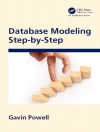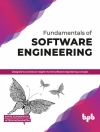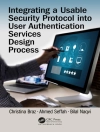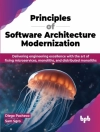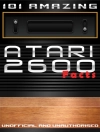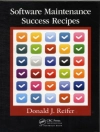Healthcare has become an extremely important and relevant topic in day to day discussions ever since the COVID-19 pandemic has been encountered by the global population. This has led to a renewed focus and attention that researchers from every discipline have put in to realize better strategies for healthcare management in general. This book is an attempt to put to use recent advancements in the field of the Internet of Medical Things often called Io MT, which is an extension of Io T for real-time, data analytics-driven prompt and quality healthcare to global citizens. Security has been always a challenge with pervasive technologies like Io MT and Io T, and thus usage of disruptive technology like blockchain to offset the security concerns that surround the data and network management. Therefore, this book is an honest attempt to provide directions to applied areas of research in Io MT for healthcare with the aid and help of Blockchain Technologies.
İçerik tablosu
1. Chapter.- 1.1. Introduction.- 1.2. Smart Healthcare and Telemedical System.- 1.2.1. Smart Healthcare Technology.- 1.2.2. Remote monitoring and automated healthcare system.- 1.2.3. Remote Care and Telehealth.- 1.2.4. Emergency response solution for connectivity.- 1.2.5. Smart Hospital Management.- 1.3. Telemedical Healthcare.- 1.3.1. Registration Phase.- 1.3.2. Login Phase and Mutual Authentication.- 1.3.3. Telemedicine Server.- 1.4. Intelligent Medical Care using Io T.- 1.5. Smart Healthcare: Challenges and Threats.- Conclusion.- References.- 2. Chapter.- 2.1. Introduction.- 2.2. Io T Related Sub-Components.- 2.2.1. Embedded programming.- 2.2.2. Hardware device.- 2.2.3. Security.- 2.2.4. Networking and cloud Integration.- 2.2.5. Data Analytics and prediction.- 2.2.6. Machine Learning and AI.- 2.3. Architecture of Io T.- .- 2.3.1. Sensors and Actuators.- 2.3.2. Internet gateway.- 2.3.3. Edge Computing IT System.- 2.3.4. Data Centre and Cloud.- 2.3.5. Application of Io T.- 2.3.6. Smart Homes.- 2.3.7. Smart Agriculture.- 2.3.8. Energy Management.- 2.3.9. Industrial Internet.- 2.4. Io T In Healthcare.- 2.4.1. Remote patient monitoring.- 2.4.2. Real time Data Tracking.- 2.4.3. Connected wearables.- 2.5. Internet of Medical Things (Io MT or Io Med T).- 2.6. Challenges for Io MT.- Conclusion.- References.- 3. Chapter.- 3.1. Introduction.- 3.2. Io T Components.- 3.2.1. Devices/Sensors.- 3.2.2. Connectivity.- 3.2.3. Data Processing.- 3.2.4. User Interface.- 3.3. Io Med T Components.- 3.3.1. Patient and Payer.- 3.3.2. Connected Medical Devices.- 3.3.3. Communication Services (Connectivity).- 3.3.4. Analytics Platform (Data Processing.- .- 3.3.5. Service Providers.- 3.4. Integration of Latest Technology with Io Med T .- 3.5. Benefits and Challenges of Io Med T .- 3.5.1. Benefits of Io Med T .- 3.5.2. Challenges in Io Med T.- Conclusion.- References.- 4. Chapter .- 4.1. Introduction to Smart healthcare and Io MT.- 4.2. Perception layer – Sensor systems for data collection .- 4.2.1. Gateway layer .- 4.2.2. Management service layer/application support layer- data storage .- 4.2.3. Application/service layer .- 4.3. Io MT: A boon in healthcare.- 4.4. Challenges of Io MT .- 4.5. Benefits of Io MT .- 4.6. Structural components of Io MT .- 4.7. Functional components of Io MT.- 4.8. Structural and Functional Challenges .- Conclusion.- References.- 5. Chapter.- 5.1. Introduction.- 5.2. Working of Blockchain .- 5.2.1. Distributed Database.- 5.2.2. A network of nodes.- 5.2.3. Building Trust.- 5.3. Benefits of Blockchain Technology.- 5.3.1. Time-saving.- .- 5.3.2. Cost-saving .- 5.3.3. Tighter security.- 5.4. Application of Blockchain .- 5.4.1. Asset Management .- 5.4.2. Cross-Border Payments .- 5.4.3. Healthcare .- 5.4.4. Cryptocurrency .- 5.4.5. Birth and Death Certificates .- 5.4.6. Online Identity Verification.- 5.4.7. Internet of Things .- 5.4.8. Copyright and Royalties .- 5.5. Application of Blockchain in Smart Healthcare .- 5.5.1. Research .- 5.5.2. Seamless switching of patients between providers .- 5.5.3. Faster, cheaper, better patient care .- 5.5.4. Interoperable electronic health records .- 5.5.5. Data security .- 5.5.6. Mobile health apps and remote monitoring .- 5.5.7. Tracing and securing medical supplies .- 5.5.8. Health insurance claims .- 5.5.9. Tracking diseases and outbreaks .- 5.5.10. Safeguarding genomics .- Conclusion.- References.- 6. Chapter .- 6.1. Introduction.- 6.2. Possible Security Attacks in DMR Internet of Things Networks.- 6.3. Security Schemes and There Challenges in DMR.- Conclusion.- .- References.- 7. Chapter.- 7.1. Introduction .- 7.2. Benefits of Io MT in Smart Healthcare .- 7.2.1. Cost Reduction .- 7.2.2. Improve Treatment .- 7.2.3. Faster Disease Diagnosis .- 7.2.4. Drug and Equipment Management .- 7.2.5. Error Reduction .- 7.3. Tools and Technique for Io MT in Smart Healthcare .- 7.3.1. Electronic Health Record (EHR) .- 7.3.2. Referral Trackers .- 7.3.3. Patient Portals .- 7.3.4. Remote Patient Monitoring .- 7.3.5. Computerized Provider Order Entry .- 7.4. Use case of Io MT in Healthcare Industry .- 7.4.1. Internet of things for patients.- 7.4.2. Internet of things for Hospitals .- 7.4.3. Internet of things for Physicians.- 7.4.4. Internet of things for Business .- 7.4.5. Internet of things for Health Insurance Companies .- 7.5. Privacy and Security Issue in Io MT.- 7.5.1. Patients are not in charge of their own information .- 7.5.2. Present to Your Own Device (BYOD) .- 7.5.3. Telecommuting presents security chances .- 7.6. Challenges of Io MT in Smart Healthcare .- 7.6.1. Underdeveloped Initiatives .- 7.6.2. Unavailability of Memory .- 7.6.3. Keeping Updated.- 7.6.4. Data Security .- 7.6.5. Global healthcare regulations .- 7.6.6. Scalable Platforms .- 7.6.7. Data Overloading .- 7.7. Impact of Io MT on the future of the healthcare industry .- Conclusion .- References.- 8. Chapter .- 8.1. Introduction .- 8.1.1. Big Data relation with Cloud Computing .- 8.1.2. Relationship between Io MT and Big Data.- 8.1.3. Big Data and the Internet of Medical Things .- 8.1.4. Io T and Cloud Computing.- 8.1.5. Benefits of using big data, Io T and the cloud .- 8.2. Io MT needs to be integrated with cloud computing .- 8.3. Integration of Io T and Cloud Computing .- 8.4. Benefits of integrating Io T and cloud computing .- Conclusion .- References .- 9. Chapter .- 9.1. Introduction.- 9.1.1. Io T in Smart Healthcare Systems.- 9.2. Background/Present state in Data security.- 9.2.1. Data Security requirements in Smart Healthcare Systems.- 9.3. Privacy and Qo S in smart healthcare.- 9.4. Data Security and Privacy Issues in Healthcare .- 9.5. Qo S Parameters for Smart Healthcare.- 9.6. Suggested Security Techniques to Preserve Qo S.- Conclusion .- References .- 10. Chapter .- 10.1. Introduction.- 10.2. Authentication Schemes for Tele Medical Healthcare System.- 10.3. Processes of an authentication protocol.- Conclusion .- References .- 11. Chapter .- 11.1. Introduction.- 11.1.1. Security .- 11.1.2. Features.- 11.2. Types of Blockchain Networks .- 11.2.1. Public blockchain network .- 11.2.2. Private blockchain network.- 11.2.3. Permissioned blockchain network.- 11.2.4. Consortium Blockchain networks.- 11.3. Applications of Blockchain.- 11.3.1. Smart contracts.- 11.3.2. Involving Blockchain into Internet of Things (IOT).- 11.3.3. Preventing Identity Theft .- 11.4. Application of Blockchain in Smart Healthcare.- 11.4.1. Keeping transparency in delivering healthcare goods.- 11.4.2. Storing of medical data of patients.- 11.4.3. Remote health monitoring using IOT and blockchain .- 11.5. Electronic Health Record (EHR) and its Storage.- 11.5.1. Medical Big Data Mining and Processing in e-Healthcar.- 11.5.2. Smart healthcare systems using big data.- 11.6. Significance of Blockchain in Security of Electronic Health Record (EHR).- Conclusion.- References .- 12. Chapter .- 12.1. Introduction.- 12.1.1. A Different Healthcare World.- 12.2. Components of Telemedicine.- 12.2.1. Teleconsultation.- 12.2.2. Telementoring.- 12.2.3. Telemonitoring.- 12.3. Emerging technologies in telemedicine .- 12.3.1. Technologies proceeding telemedicine.- 12.3.2. m RNA Technology.- 12.3.3. Neurotechnology.- 12.3.4. Precision Medicine.- 12.3.5. Clustered Regularly Interspaced Short Palindromic Repeats (CRISPR).- 12.3.6. Health Wearables.- 12.3.7. Technology in Mental Health.- 12.3.8. Artificial Intelligence.- 12.3.9. Augmented and virtual reality.- 12.3.10. Tele-robots .- 12.3.11. Io T and nanotechnology .- 12.3.12. 3D Printing.- 12.3.13. Enhanced Access to Medical Data and Information.- 12.3.14. Big Data.- 12.3.15. Improved Lines of Communication.- 12.3.16. Electronic Health Records.- 12.3.17. Metaverse.- Conclusion .- References .- 13. Chapter.- 13.1. Introduction.- 13.1.1. AI and Machine Learning .- 13.1.2. Cloud Computing .- 13.1.3. Cyber security/Cloud Security .- 13.2. Role of Artificial Intelligence, Cloud Computing, and Internet Security in Smart Healthcare .- 13.2.1. Artificial Intelligence and Machine Learning (AIML) in Healthcare Systems 182.- 13.2.2. Early Cancer Diagnosis .- 13.2.3. Diagnosis of Fatal Blood Diseases .- 13.2.4. Customer Service Chatbots .- 13.2.5. Managing the Medical Records .- 13.2.6. Dosage Errors .- 13.2.7. Robotic Surgeries .- 13.3. Cloud Computing in Healthcare Systems .- 13.4. Security Challenge in Smart Healthcare .- Conclusion.- References .- 14. Chapter .- 14.1. Introduction .- 14.1.1. Capturing storage techniques for healthcare data .- 14.1.2. About Healthcare Data .- 14.1.3. Data storage .- 14.1.4. Onsite data storage .- 14.1.5. Public cloud data storage .- 14.1.6. Hybrid cloud data storage solution .- 14.1.7. Benefits of storing data on the cloud from multiple sources .- 14.2. ML-enabled storage systems .- 14.3. The current state of technology .- 14.4. Enhancing existing Enterprise Data Warehouses (EDW) .- 14.5. Background work .- 14.6. ML techniques for treatment of healthcare data .- 14.7. Smart access techniques for storage systems .- 14.8. Prediction of diseases on healthcare data, both batch, and real-time data streams 197.- Conclusion .- References .- 15. Chapter .- 15.1. Introduction .- 15.2. Smart Healthcare Tools and Techniques .- 15.2.1. Cloud Computing in Smart Healthcare .- 15.2.2. Medical Records Centralization .- 15.2.3. Promoting Patient Engagement .- 15.2.4. Better Scalability .- 15.2.5. Cost-Effectiveness .- 15.2.6. Advanced Analytics for Healthcare .- 15.3. Current and Future application of AI, Io T, Blockchain and Cloud Computing in Smart Healthcare . 210.- 15.3.1. Applications of Artificial Intelligence in Smart Healthcare .- 15.3.2. Machine learning neural networks and deep learning .- 15.3.3. Physical robots 15.3.4. Natural language processing (NLP) .- 15.3.5. Applications of Internet of Things (Io T) in Smart Healthcare.- 15.3.6. Applications of Blockchain in Smart Healthcare .- 15.3.7. Applications of Cloud Computing in Smart Healthcare .- 15.4. Challenges in Smart Healthcare .- 15.4.1. Availability .- 15.4.2. Data Centralization .- 15.4.3. Privacy/Security .- 15.4.4. Open Access.- 15.5. Future of Smart Healthcare and Telemedicine.- Conclusion.- References.
Yazar hakkında
Dr Sunil Gupta has over more than 19 Years of experience in teaching, research and industry in the field of Computer science and Engineering. Prior to joining UPES as a Professor, he has worked with, BML Munjal University, Delhi Technical Campus, IP University, Northern India Engineering College, IP University, IIMT, Baddi University of Emerging Science, IFTM University. He has conducted various workshops, conferences and FDP. He Guides various students for research and project work. He is an authored many research papers, Six Patents and Two textbooks, namely Cryptography and Network Security and Wireless Sensor Networks. His academic interest includes Security, Cloud Computing, Big Data, Sensor, Wireless Networks, and Healthcare. He has been regularly invited as a technical expert in different committees by both private and government organizations. As an Expert for Recruiting faculty by different colleges affiliated to GGSIPU. Nominated in JAC (Joint Assessment Committee) as a Technical Expert by GGSIPU to Evaluate the functioning of various colleges (both Govt. and Private) affiliated to it. He is a Reviewer of International Journal namely Journal of Supercomputing, published by Springer Netherlands., International Journal of Wireless Networks by Springer, International Journal Computer and Electrical Engineering, Singapore.
Dr Hitesh Kumar Sharma is working as Senior Associate Professor at School of Computer Science, University of Petroleum and Energy Studies, Dehradun, Uttarakhand, India. He did his Ph.D. in Database Performance Tuning in 2016. He has completed his M.Tech. in 2009. Currently he is also working in Machine Learning, Deep Learning, Image Processing and Io T with Blockchain. He has authored more than 60 research articles in the journal and conferences of repute nationally and internationally. Dr. Sharma have authored 04 books and 30+-book chapter with international publishers like Springer. He is active Guest Editor/Reviewer of various referred International journals. He has delivered various Keynote/Guest speech in India and abroad. He got many certifications in Dev Ops in last two years. He has also published 20 Patents in his academic career in last few years.
Dr Monit Kapoor is currently serving at Chitkara University, Punjab, India as Dean in Department of Computer Science and Engineering. He has around 25 years of experience out of which 15 years has been in academia and 10 years has been in industry. He has guided 2 Ph D scholars in the area of Sensor networks and Flying Ad hoc networks, whose Ph D is completed and in addition to this he is currently guiding 4 Ph D scholars in the area of Mobile Security, Vehicular Fog Computing and Artificial Intelligence. He has a total of 25 Publications to his credit in reputed journals and conferences. He has filed 5 patents as well. He is a reviewer of many international journals and has been on TPC and acted as session chair in many international conferences of repute. He is part of a working group on Mobile Security Guidelines set up by Ministry of Electronics and IT(MEITY), Government of India. He has been recognized as among top 50 tech savvy academicians in India in year 2020. In his free time, he likes to tune into music, and he loves to travel to far off destinations around the country during breaks


